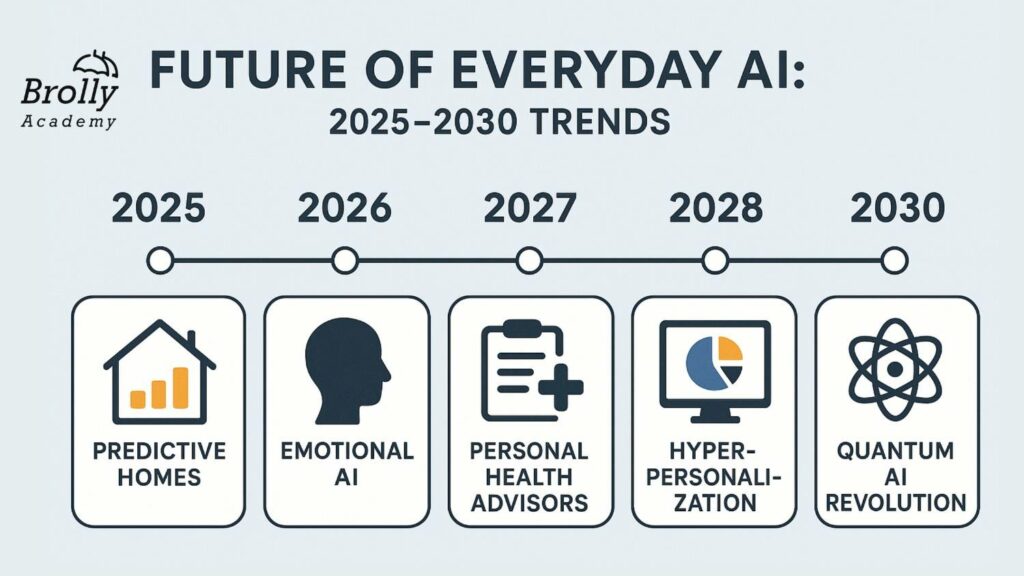Examples of Artificial Intelligence in Everyday Life
introduction to Examples of Artificial Intelligence in Everyday Life
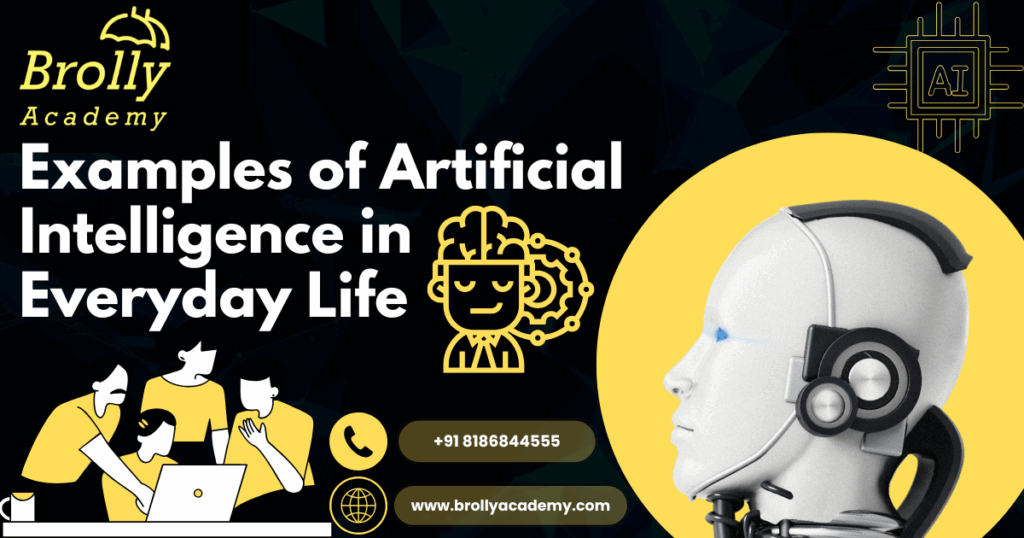
- Artificial Intelligence (AI) has transitioned from a futuristic concept discussed in research labs to an essential part of our daily lives.
- Without realizing it, most of us interact with AI dozens of times a day — from the moment we check our smartphones in the morning to when we stream our favorite shows at night.
- AI is now quietly embedded into the technologies we rely on, shaping experiences, solving problems, and even anticipating our needs in ways that would have been unimaginable just a few decades ago.
What is Artificial Intelligence?
- Artificial Intelligence, or AI, refers to the creation of computer systems that can perform tasks typically requiring human intelligence.
- These tasks include learning from experience, understanding language, recognizing patterns, solving problems, and making decisions.
- Unlike traditional computer programs that follow rigid, pre-defined instructions, AI systems are designed to adapt and improve.
- They can learn from data, adjust to new inputs, and even predict outcomes without being explicitly programmed for every scenario.
Different Types of AI at a Glance:
| Type of AI | Description | Everyday Example |
| Narrow AI | Specializes in a single task | Siri answering a question |
| General AI | Human-level intelligence across tasks (theoretical) | Still under research |
| Reactive Machines | Respond to immediate input without memory | Chess AI responding to moves |
| Limited Memory AI | Learn from historical data for better decisions | Self-driving cars adjusting routes |
Why Artificial Intelligence Is Now Part of Everyday Life
1. Explosion of Data
- The digital revolution created massive amounts of data — from social media activity to online purchases to GPS locations.
- AI thrives on data. The more information available, the better it can learn, adapt, and provide smarter services.
- Smartphones, IoT devices, and connected systems now generate exabytes of data daily, giving AI an endless stream of material to work with.
2. Improved Computing Power
- Advancements in cloud computing, edge computing, and specialized AI hardware (like GPUs and TPUs) have made it possible to process vast datasets at incredible speeds.
- What once took supercomputers days to analyze can now be completed in seconds, allowing AI applications to work seamlessly in real-time across millions of devices.
3. Democratization of AI Tools
- Previously, AI development was limited to large corporations and research institutions.
- Today, open-source frameworks like TensorFlow, PyTorch, and Hugging Face allow startups, small businesses, and even solo developers to create powerful AI models.
- Affordable AI APIs and cloud services have brought AI to a mass audience, making AI solutions accessible and affordable for organizations of all sizes.
4. Consumer Demand for Personalization and Convenience
- Modern consumers expect highly personalized experiences — from movie recommendations tailored to their tastes to smart homes that automatically adjust to their routines.
- AI delivers this personalization at scale, analyzing individual preferences and delivering services that feel tailor-made.
- Convenience, speed, and hyper-personalization have become the new standard, and AI is the invisible engine powering it.
5. Competitive Advantage in Every Industry
- From finance and healthcare to entertainment and education, companies that effectively integrate AI into their operations are outperforming those that don’t.
- AI enables businesses to automate tasks, gain insights, optimize marketing, improve customer service, and innovate faster than ever before.
- As a result, AI is no longer a luxury — it is a strategic necessity, pushing industries to invest heavily in embedding AI across all levels of operation.
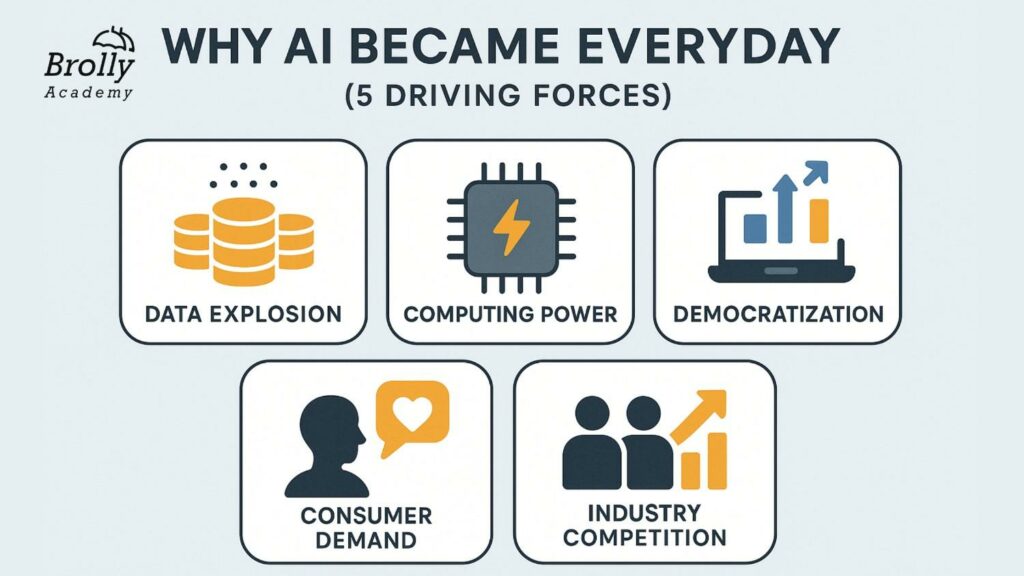
Top 20+ Real-World Examples of Artificial Intelligence in Everyday Life
From morning alarms set by smart devices to late-night movie recommendations, Artificial Intelligence powers much of the modern human experience. Below are 20+ real-world examples of how AI quietly, yet powerfully, touches daily life across industries and activities.
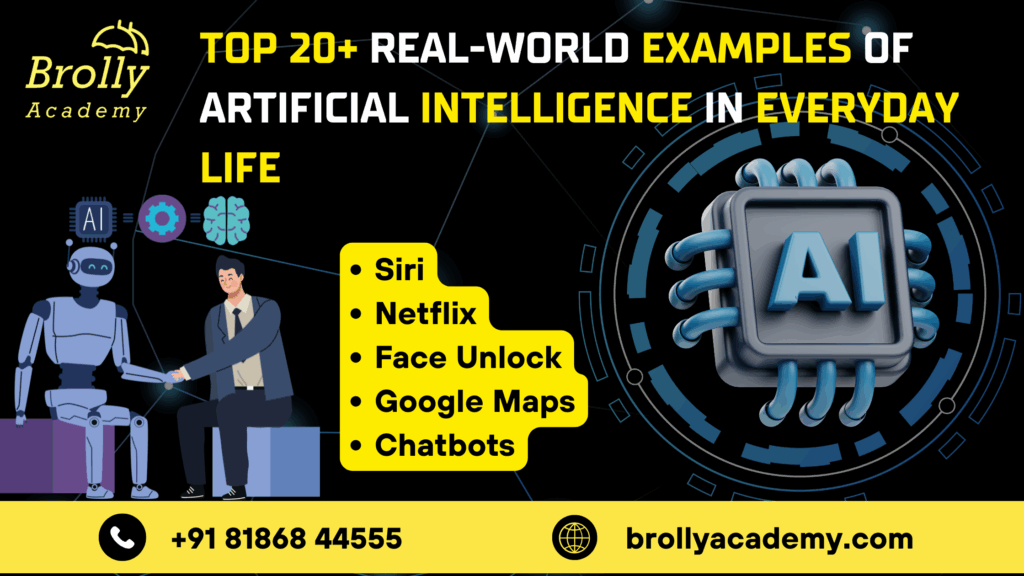
1. Smartphones and Virtual Assistants
- Facial Recognition Unlocking:
- AI-driven facial recognition systems scan and analyze intricate facial patterns to authenticate users instantly.
- Systems like Apple’s Face ID or Samsung’s Face Unlock ensure both seamless access and enhanced device security without the need for passwords or PINs.
- AI-driven facial recognition systems scan and analyze intricate facial patterns to authenticate users instantly.
- Voice Assistants:
- Virtual assistants such as Siri, Google Assistant, and Amazon Alexa use Natural Language Processing (NLP) and deep learning to interpret voice commands.
- They can answer questions, set reminders, send texts, control smart home devices, play music, and even engage in casual conversation — all hands-free.
- Virtual assistants such as Siri, Google Assistant, and Amazon Alexa use Natural Language Processing (NLP) and deep learning to interpret voice commands.
- Predictive Text and Auto-Correct:
- AI-powered predictive keyboards learn from user typing habits to suggest next words, auto-correct spelling mistakes, and personalize communication styles.
- Apps like Gboard, SwiftKey, and native smartphone keyboards rely on machine learning models to continually improve typing speed and accuracy.
- AI-powered predictive keyboards learn from user typing habits to suggest next words, auto-correct spelling mistakes, and personalize communication styles.
- Real-World Impact:
- Most users interact with AI dozens of times per hour through their smartphones — often without even realizing it.
- AI enhances user experiences by making smartphones smarter, faster, safer, and more personalized.
- Most users interact with AI dozens of times per hour through their smartphones — often without even realizing it.
✅ Key Takeaway:
AI has transformed smartphones from simple communication devices into intelligent, adaptive personal assistants embedded into our daily routines.
2. Smart Home Devices
- Smart Thermostats (e.g., Nest, Ecobee):
- AI-enabled thermostats learn user temperature preferences over time and automatically adjust heating or cooling to optimize both comfort and energy savings.
- They predict when residents are home or away, integrating with weather forecasts and user schedules to reduce unnecessary energy usage.
- AI-enabled thermostats learn user temperature preferences over time and automatically adjust heating or cooling to optimize both comfort and energy savings.
- Smart Lights:
- AI-powered lighting systems like Philips Hue or LIFX adjust brightness and color based on user routines, time of day, or even mood detection from wearable devices.
- Some systems even simulate occupancy patterns to enhance home security while the user is away.
- AI-powered lighting systems like Philips Hue or LIFX adjust brightness and color based on user routines, time of day, or even mood detection from wearable devices.
- Home Security Systems:
- Smart surveillance cameras and doorbells, such as Ring or Nest Cam, use AI-based facial recognition to differentiate between familiar faces, pets, delivery personnel, or unknown visitors.
- Tailored alerts are sent to homeowners, providing better security awareness while reducing false alarms.
- Smart surveillance cameras and doorbells, such as Ring or Nest Cam, use AI-based facial recognition to differentiate between familiar faces, pets, delivery personnel, or unknown visitors.
- Real-World Impact:
AI transforms traditional passive living spaces into intelligent, responsive homes — seamlessly adapting to user habits, boosting safety, lowering utility bills, and enhancing overall quality of life.
✅ Key Takeaway:
AI turns ordinary houses into smart, intuitive environments, offering proactive comfort, security, and sustainability with minimal human intervention.
3. Streaming Services and Content Recommendations
- Content Personalization
- Platforms like Netflix, Spotify, YouTube, and Amazon Prime use AI to analyze each user’s viewing or listening history, interaction patterns, preferences, and even time-of-day usage.
- Based on these insights, AI recommends personalized movies, shows, videos, or music playlists that users are most likely to enjoy — dramatically improving satisfaction and engagement.
- Platforms like Netflix, Spotify, YouTube, and Amazon Prime use AI to analyze each user’s viewing or listening history, interaction patterns, preferences, and even time-of-day usage.
- Dynamic Thumbnails:
- Services like Netflix employ AI to personalize not just content recommendations but also how they are visually presented.
- Depending on a user’s previous choices, AI dynamically selects thumbnails for a movie or show that are most likely to appeal to that specific viewer, subtly boosting click-through rates.
- Services like Netflix employ AI to personalize not just content recommendations but also how they are visually presented.
- Real-World Impact:
- Users save valuable time by instantly discovering relevant entertainment, rather than scrolling endlessly through large libraries.
- Personalization makes the viewing or listening experience feel tailor-made, increasing platform loyalty and user happiness.
- Users save valuable time by instantly discovering relevant entertainment, rather than scrolling endlessly through large libraries.
4. E-commerce and Personalized Shopping
Artificial Intelligence is the invisible engine behind today’s seamless, personalized, and highly dynamic online shopping experiences.
- Product Recommendations:
- Platforms like Amazon, Flipkart, and eBay use AI to analyze browsing history, cart behavior, past purchases, and even similar customers’ buying habits.
- Based on these insights, AI suggests products that users are most likely to be interested in — boosting discovery, convenience, and purchase satisfaction.
- Platforms like Amazon, Flipkart, and eBay use AI to analyze browsing history, cart behavior, past purchases, and even similar customers’ buying habits.
- Dynamic Pricing:
- Retailers deploy AI models to adjust product prices in real-time based on factors like customer demand, stock availability, competitor pricing, seasonal trends, and even individual customer behavior.
- This strategy maximizes sales opportunities while offering customers better deals at the right moments.
- Retailers deploy AI models to adjust product prices in real-time based on factors like customer demand, stock availability, competitor pricing, seasonal trends, and even individual customer behavior.
- Customer Service Chatbots:
- AI-powered chatbots assist shoppers by answering frequently asked questions, providing order status updates, suggesting complementary products, and resolving basic issues — available 24/7 without wait times.
- Advanced bots can even offer personalized product recommendations based on a shopper’s browsing session.
- AI-powered chatbots assist shoppers by answering frequently asked questions, providing order status updates, suggesting complementary products, and resolving basic issues — available 24/7 without wait times.
- Real-World Impact:
- E-commerce becomes faster, smarter, and deeply customized, giving shoppers a smoother buying journey and helping businesses increase conversion rates.
- Customers enjoy more relevant choices, better prices, and instant support, all made possible by AI working invisibly in the background.
- E-commerce becomes faster, smarter, and deeply customized, giving shoppers a smoother buying journey and helping businesses increase conversion rates.
5. Social Media Feeds and Targeted Advertising
- Feed Curation:
- Platforms like Facebook, Instagram, Twitter, and LinkedIn use AI to analyze user interactions — such as likes, shares, comments, and time spent on posts.
- AI models predict the content that will most likely engage each user and reorder the newsfeed in real-time to prioritize highly relevant posts, stories, and updates.
- Platforms like Facebook, Instagram, Twitter, and LinkedIn use AI to analyze user interactions — such as likes, shares, comments, and time spent on posts.
- Targeted Ads:
- AI tracks browsing habits, purchase behaviors, interests, and demographic data to deliver hyper-personalized advertisements to users.
- Instead of showing generic ads, brands can now reach highly segmented audiences, leading to higher engagement rates and more effective marketing outcomes.
- AI tracks browsing habits, purchase behaviors, interests, and demographic data to deliver hyper-personalized advertisements to users.
- Real-World Impact:
- Every like, click, search, and interaction feeds back into AI models, fine-tuning the user experience and making social media feeds feel uniquely personal and addictive.
- Every like, click, search, and interaction feeds back into AI models, fine-tuning the user experience and making social media feeds feel uniquely personal and addictive.
For businesses, AI-powered advertising increases ROI by connecting with audiences more precisely than traditional marketing ever could.
6. Navigation and Traffic Prediction
- Route Optimization:
- Apps like Google Maps, Waze, and Apple Maps leverage AI algorithms to analyze real-time traffic data, accident reports, construction updates, and weather conditions.
- AI dynamically recommends the fastest or most efficient routes, rerouting drivers instantly if better options arise during the journey.
- Apps like Google Maps, Waze, and Apple Maps leverage AI algorithms to analyze real-time traffic data, accident reports, construction updates, and weather conditions.
- Arrival Time Prediction:
- By combining historical traffic trends with live congestion data, AI models predict estimated arrival times (ETA) with impressive accuracy.
- This predictive ability helps users plan commutes, deliveries, and appointments more reliably, reducing uncertainty and stress.
- By combining historical traffic trends with live congestion data, AI models predict estimated arrival times (ETA) with impressive accuracy.
- Real-World Impact:
- Millions of commuters and travelers save hours each week by using AI-driven navigation, experiencing fewer traffic jams, more predictable travel times, and greater convenience.
- In broader terms, smarter navigation also reduces fuel consumption and lowers environmental impacts by minimizing idle time and unnecessary detours.
- Millions of commuters and travelers save hours each week by using AI-driven navigation, experiencing fewer traffic jams, more predictable travel times, and greater convenience.
7. Online Banking and Fraud Detection
- Fraud Detection Systems:
- AI models continuously monitor user behavior, transaction history, and spending patterns to detect anomalies that could indicate fraudulent activities.
- When unusual transactions — like an unexpected international charge or unusually large withdrawal — are detected, AI systems trigger real-time alerts or temporarily freeze the account for verification, minimizing financial risks.
- AI models continuously monitor user behavior, transaction history, and spending patterns to detect anomalies that could indicate fraudulent activities.
- AI Customer Support:
- Banks like Bank of America (Erica), Wells Fargo, and HDFC Bank now offer AI-driven chatbots capable of answering frequently asked questions, guiding users through balance inquiries, fund transfers, loan information, and more — available 24/7.
- These AI systems provide instant support without the need for long call center wait times, while seamlessly escalating complex issues to human agents when needed.
- Banks like Bank of America (Erica), Wells Fargo, and HDFC Bank now offer AI-driven chatbots capable of answering frequently asked questions, guiding users through balance inquiries, fund transfers, loan information, and more — available 24/7.
- Real-World Impact:
- AI strengthens financial security by catching fraud faster than traditional manual systems and enhances customer service efficiency by resolving most queries within seconds.
- Users experience safer transactions, quicker support, and increased trust in online banking services.
- AI strengthens financial security by catching fraud faster than traditional manual systems and enhances customer service efficiency by resolving most queries within seconds.
8. Healthcare and Fitness Apps
- Symptom Checkers (e.g., Ada Health):
- AI-powered apps like Ada Health allow users to input symptoms and receive potential condition assessments.
- The AI analyzes millions of case histories, medical research, and symptom patterns to suggest possible causes, helping users decide whether to seek professional medical advice sooner.
- AI-powered apps like Ada Health allow users to input symptoms and receive potential condition assessments.
- Fitness Tracking:
- Smartwatches such as Fitbit, Apple Watch, and Garmin utilize AI to monitor vital signs like heart rate, oxygen saturation, sleep quality, stress levels, and activity intensity.
- These devices detect early anomalies — such as irregular heart rhythms — and notify users, promoting proactive health management and preventive interventions.
- Smartwatches such as Fitbit, Apple Watch, and Garmin utilize AI to monitor vital signs like heart rate, oxygen saturation, sleep quality, stress levels, and activity intensity.
- Real-World Impact:
- Everyday AI integration into healthcare apps enables constant health monitoring, early warning alerts, and personalized wellness insights — empowering individuals to lead healthier, more informed lifestyles.
- The shift from reactive to preventive healthcare through AI could reduce chronic disease risks and improve long-term quality of life globally.
- Everyday AI integration into healthcare apps enables constant health monitoring, early warning alerts, and personalized wellness insights — empowering individuals to lead healthier, more informed lifestyles.
9. Smart Cars and Driver Assistance
- Driver Assistance Systems:
- AI powers features such as lane-keeping assistance, adaptive cruise control, collision avoidance, and automatic emergency braking.
- These systems continuously analyze real-time sensor data — including cameras, LiDAR, radar, and GPS — to predict potential dangers and take corrective actions before accidents happen.
- Modern cars can automatically maintain safe distances, adjust speed to traffic flow, and help drivers stay centered in their lanes.
- AI powers features such as lane-keeping assistance, adaptive cruise control, collision avoidance, and automatic emergency braking.
- Self-Driving Initiatives:
- Companies like Tesla, Waymo, and Cruise employ advanced AI models to enable vehicles to interpret complex road conditions, pedestrian movements, traffic patterns, and unpredictable scenarios.
- Through deep learning, computer vision, and reinforcement learning, autonomous vehicles are steadily becoming capable of navigating urban streets and highways with minimal human intervention.
- Companies like Tesla, Waymo, and Cruise employ advanced AI models to enable vehicles to interpret complex road conditions, pedestrian movements, traffic patterns, and unpredictable scenarios.
- Real-World Impact:
- AI significantly improves road safety, driving convenience, and fuel efficiency, reducing the frequency of human errors — the leading cause of accidents.
- Each advancement in driver assistance technology brings society one step closer to the widespread adoption of fully autonomous vehicles, revolutionizing mobility for all.
10. Email Spam Filters and Smart Replies
- Spam Filters:
- AI algorithms monitor incoming emails for suspicious patterns, sender reputations, malicious links, and unusual language indicators.
- Systems like Gmail’s spam detection automatically identify and quarantine unwanted or dangerous emails, protecting users from phishing attacks, scams, and unnecessary clutter.
- AI algorithms monitor incoming emails for suspicious patterns, sender reputations, malicious links, and unusual language indicators.
- Smart Reply Suggestions:
- Platforms like Gmail and Outlook use Natural Language Processing (NLP) to understand the content and tone of received emails.
- Based on this analysis, they suggest short, contextually relevant responses — enabling users to reply quickly with a single click, saving time during busy workflows.
- Platforms like Gmail and Outlook use Natural Language Processing (NLP) to understand the content and tone of received emails.
- Real-World Impact:
- Email communication becomes cleaner, faster, and more productive, requiring far less manual filtering and effort from users.
- Businesses and individuals alike experience improved email hygiene, better focus, and a significantly enhanced digital communication experience.
- Email communication becomes cleaner, faster, and more productive, requiring far less manual filtering and effort from users.
11. Online Education and AI Tutors
- Adaptive Learning Platforms (e.g., Coursera, Duolingo):
- AI algorithms analyze individual student performance, engagement levels, and knowledge gaps.
- Based on this analysis, platforms dynamically adjust the difficulty, pace, and sequence of lessons to fit each learner’s evolving needs.
- Students receive personalized quizzes, targeted practice exercises, and recommended supplementary materials to enhance retention.
- AI algorithms analyze individual student performance, engagement levels, and knowledge gaps.
- Essay Grading and Feedback:
- AI-driven tools used by platforms like Gradescope and Turnitin evaluate written assignments quickly and consistently.
- These systems provide real-time feedback on grammar, coherence, structure, and originality — helping students refine their writing skills without waiting days for manual grading.
- AI-driven tools used by platforms like Gradescope and Turnitin evaluate written assignments quickly and consistently.
- Real-World Impact:
- Learners experience highly individualized educational pathways, increasing motivation, engagement, and mastery of subjects.
- AI reduces the burden on teachers while ensuring that students receive immediate, actionable feedback that accelerates improvement.
- Learners experience highly individualized educational pathways, increasing motivation, engagement, and mastery of subjects.
12. Gaming AI
- NPC Behavior (Non-Playable Characters):
- AI algorithms allow NPCs (characters not controlled by players) to behave intelligently and adaptively.
- Instead of following rigid scripts, NPCs react dynamically to player choices, strategies, and even emotions, creating richer storytelling and deeper engagement.
- Popular examples include Red Dead Redemption 2, The Last of Us, and Assassin’s Creed series, where AI-driven characters evolve based on player actions.
- AI algorithms allow NPCs (characters not controlled by players) to behave intelligently and adaptively.
- Procedural Content Generation:
- AI enables real-time creation of vast open-world environments, new game levels, dynamic story arcs, and unexpected challenges without manual design.
- Games like Minecraft, No Man’s Sky, and Rogue Legacy use AI to generate unique worlds and adventures every time a player starts a new session, greatly increasing replay value.
- AI enables real-time creation of vast open-world environments, new game levels, dynamic story arcs, and unexpected challenges without manual design.
- Real-World Impact:
- Gaming experiences become more interactive, less predictable, and highly personalized, providing endless exploration, strategy variations, and emotional connections.
- Players encounter unique challenges and stories tailored to their playstyles, making every journey unforgettable.
- Gaming experiences become more interactive, less predictable, and highly personalized, providing endless exploration, strategy variations, and emotional connections.
13. Voice Translation and Language Apps
- AI Translators (e.g., Google Translate):
- AI models trained on massive multilingual datasets instantly translate voice commands, text inputs, and even visual content (like menus or signs) across dozens of languages.
- Applications such as Google Translate, Microsoft Translator, and DeepL provide near-instant translation, helping travelers, professionals, and global teams connect effortlessly.
- AI models trained on massive multilingual datasets instantly translate voice commands, text inputs, and even visual content (like menus or signs) across dozens of languages.
- Speech-to-Text Engines:
- Advanced AI-powered engines like Otter.ai and Dragon NaturallySpeaking convert spoken words into accurate text transcripts in real-time.
- This enhances communication for people with hearing impairments, improves accessibility in meetings and webinars, and supports content creation across different languages and dialects.
- Advanced AI-powered engines like Otter.ai and Dragon NaturallySpeaking convert spoken words into accurate text transcripts in real-time.
- Real-World Impact:
- Cross-cultural communication becomes faster, smoother, and more inclusive, opening up new personal, educational, and professional opportunities worldwide.
- Language is no longer a barrier to collaboration, innovation, or travel — AI breaks down borders and connects people globally in real-time.
- Cross-cultural communication becomes faster, smoother, and more inclusive, opening up new personal, educational, and professional opportunities worldwide.
| AI Example | Industry | Real-World Application |
| Virtual Assistants | Consumer Tech | Siri, Alexa |
| Smart Home Devices | Home Automation | Nest, Ring |
| Streaming Recommendations | Entertainment | Netflix, Spotify |
| Smart Navigation | Transportation | Google Maps, Waze |
| Healthcare AI Apps | Health and Fitness | Ada Health, Fitbit |
14. Industrial Robots in Manufacturing and Warehousing
- Assembly Line Robotics:
- AI enables robotic arms to perform complex assembly tasks that require extreme precision and adaptability.
- Modern industrial robots can detect subtle variations in part positioning, automatically adjust their movements, and maintain high-quality production without human intervention.
- Applications span automotive manufacturing, electronics assembly, and heavy machinery production.
- AI enables robotic arms to perform complex assembly tasks that require extreme precision and adaptability.
- Warehouse Automation:
- Logistics giants like Amazon, Alibaba, and FedEx employ AI-driven robotic fleets in fulfillment centers to automate picking, sorting, packaging, and transporting goods.
- AI optimizes the robots’ navigation routes, predicts order patterns, and manages inventory dynamically — significantly reducing human labor requirements and operational costs.
- Logistics giants like Amazon, Alibaba, and FedEx employ AI-driven robotic fleets in fulfillment centers to automate picking, sorting, packaging, and transporting goods.
- Real-World Impact : Manufacturing and warehousing operations become faster, safer, and vastly more efficient, minimizing errors, reducing workplace injuries, and enabling just-in-time production models that support global commerce.
15. Smart Wearables for Health and Fitness Monitoring
- Activity Recognition:
- Devices like Fitbit, Apple Watch, and Garmin use AI algorithms to automatically recognize various activities such as walking, running, cycling, swimming, and even workouts like yoga or weightlifting.
- AI intelligently classifies the activity type, tracks duration, intensity, and provides users with accurate performance feedback without manual input.
- Devices like Fitbit, Apple Watch, and Garmin use AI algorithms to automatically recognize various activities such as walking, running, cycling, swimming, and even workouts like yoga or weightlifting.
- Health Monitoring:
- AI in wearables continuously monitors vital health metrics such as heart rate variability, oxygen saturation (SpO₂), respiratory rate, and sleep cycles.
- Advanced models can detect irregularities that may signal underlying conditions — such as arrhythmias, sleep apnea, or stress levels — and alert users to seek medical attention when necessary.
- AI in wearables continuously monitors vital health metrics such as heart rate variability, oxygen saturation (SpO₂), respiratory rate, and sleep cycles.
- Real-World Impact:
- Users receive real-time health insights, early warnings about potential health risks, and personalized fitness coaching recommendations tailored to their unique physiology.
- Wearables empower individuals to take proactive control of their wellness, leading to healthier, more informed lifestyles.
- Users receive real-time health insights, early warnings about potential health risks, and personalized fitness coaching recommendations tailored to their unique physiology.
16. Facial Recognition in Devices and Public Spaces
- Smartphones and Laptops:
- Devices like the iPhone’s Face ID, Samsung Galaxy’s Face Unlock, and Windows Hello use deep learning models to accurately recognize individual facial features.
- These AI systems enable users to securely unlock devices, authorize payments, and access sensitive apps within seconds, reducing reliance on passwords or PIN codes.
- Devices like the iPhone’s Face ID, Samsung Galaxy’s Face Unlock, and Windows Hello use deep learning models to accurately recognize individual facial features.
- Airports and Border Security:
- AI-driven facial recognition systems are increasingly deployed in airports to streamline identity verification, enhance security screening, and reduce wait times for travelers.
- Automated passport control kiosks and boarding gates now allow passengers to move swiftly through checkpoints without needing manual document checks.
- AI-driven facial recognition systems are increasingly deployed in airports to streamline identity verification, enhance security screening, and reduce wait times for travelers.
- Real-World Impact:
- Authentication processes across personal and public domains have become faster, smoother, and more secure, improving user experience and operational efficiency.
- However, concerns remain regarding privacy, data protection, and the ethical implications of surveillance, emphasizing the need for transparent regulations and responsible use.
- Authentication processes across personal and public domains have become faster, smoother, and more secure, improving user experience and operational efficiency.
17. Robot Vacuum Cleaners
- Path Optimization:
- Devices like iRobot’s Roomba, Ecovacs Deebot, and Roborock use AI algorithms to create detailed maps of rooms and living spaces.
- They calculate the most efficient cleaning routes, adjusting dynamically based on room layout, furniture placement, and surface types to maximize coverage while minimizing cleaning time.
- Devices like iRobot’s Roomba, Ecovacs Deebot, and Roborock use AI algorithms to create detailed maps of rooms and living spaces.
- Obstacle Avoidance:
- Advanced AI vision and sensor systems enable robot vacuums to recognize obstacles such as furniture, toys, pets, and even stair drop-offs.
- Instead of random bumping, these devices intelligently navigate around objects, ensuring safe, uninterrupted operation.
- Advanced AI vision and sensor systems enable robot vacuums to recognize obstacles such as furniture, toys, pets, and even stair drop-offs.
- Real-World Impact:
- Homeowners enjoy hands-free, automated cleaning, freeing up hours of time each week.
- Homeowners enjoy hands-free, automated cleaning, freeing up hours of time each week.
Robot vacuums maintain cleaner living spaces with minimal human involvement, improving daily life convenience — especially for busy households and elderly individuals.
18. Food Delivery and Ride-Hailing Apps
Artificial Intelligence plays a critical role in optimizing logistics for food delivery and ride-hailing platforms, ensuring fast, smooth, and highly responsive services for millions of users daily.
- Predictive Demand Forecasting:
- Apps like Uber Eats, Swiggy, and DoorDash use AI to anticipate peak times, such as lunch hours or weekend nights.
- Based on historical patterns, current weather conditions, traffic data, and special events, AI adjusts driver availability, restaurant preparation times, and delivery dispatching to meet expected demand.
- Apps like Uber Eats, Swiggy, and DoorDash use AI to anticipate peak times, such as lunch hours or weekend nights.
- Dynamic Pricing (Surge Pricing):
- Ride-hailing platforms like Uber and Lyft leverage AI to monitor supply and demand in real-time.
- When demand surges — for example, during a rainstorm or after a concert — AI algorithms dynamically increase prices to encourage more drivers to become available, balancing market supply.
- Ride-hailing platforms like Uber and Lyft leverage AI to monitor supply and demand in real-time.
- Real-World Impact:
- Delivery and ride times are significantly reduced, customers experience more predictable wait times, and drivers benefit from optimized earnings opportunities.
- Logistics efficiency improves overall, creating a better experience for both service providers and consumers.
- Delivery and ride times are significantly reduced, customers experience more predictable wait times, and drivers benefit from optimized earnings opportunities.
19. Customer Support Chatbots
- Instant Query Handling:
- AI-powered bots from platforms like Drift, Intercom, and Zendesk manage a wide range of tasks, including answering FAQs, assisting with product navigation, and providing step-by-step troubleshooting.
- For complex cases, AI systems smartly escalate the query to human agents, ensuring seamless service continuity.
- AI-powered bots from platforms like Drift, Intercom, and Zendesk manage a wide range of tasks, including answering FAQs, assisting with product navigation, and providing step-by-step troubleshooting.
- Personalized Support:
- Modern AI chatbots learn from every user interaction, gradually building context awareness and memory of previous conversations.
- Over time, bots can tailor responses, recommend personalized solutions, and even predict user needs based on past behavior patterns.
- Modern AI chatbots learn from every user interaction, gradually building context awareness and memory of previous conversations.
- Real-World Impact:
- Businesses can offer round-the-clock customer support without the costs associated with maintaining large human call centers.
- Customers experience faster resolution times, consistent service quality, and the convenience of getting assistance anytime — day or night.
20. AI Photography and Image Editing Tools
- AI Camera Enhancements:
- Smartphone cameras powered by AI automatically adjust exposure, focus, white balance, and lighting based on real-time scene recognition.
- Features like portrait mode, night mode, and HDR optimization are all enhanced by AI algorithms analyzing the scene conditions.
- Smartphone cameras powered by AI automatically adjust exposure, focus, white balance, and lighting based on real-time scene recognition.
- Automatic Editing Tools:
- Applications such as Adobe Photoshop’s Sensei AI and Luminar AI offer one-click enhancements, automatic background removal, and intelligent object detection.
- AI suggests composition improvements, color corrections, and even artistic transformations to make images visually striking with minimal manual intervention.
- Applications such as Adobe Photoshop’s Sensei AI and Luminar AI offer one-click enhancements, automatic background removal, and intelligent object detection.
- Real-World Impact:
- Even users with no professional photography training can produce images that rival expert-level work.
- Social media content creation, personal branding, e-commerce photography, and creative projects are now faster, easier, and more polished thanks to AI assistance.
- Even users with no professional photography training can produce images that rival expert-level work.
21. AI in Cybersecurity and Threat Detection
Anomaly Detection:
AI systems continuously monitor network traffic, user behavior, and system activities to identify deviations from normal patterns.
By detecting subtle anomalies — such as unusual login times, irregular data transfers, or unexpected system commands — AI can spot potential breaches long before traditional security measures would notice.
Predictive Threat Modeling:
Leading cybersecurity firms like CrowdStrike and Darktrace use AI-powered platforms to predict, prioritize, and neutralize threats before they escalate.
By analyzing global attack patterns, emerging vulnerabilities, and evolving hacker tactics, AI models forecast potential risks and recommend proactive defenses in real-time.
Real-World Impact:
Organizations that integrate AI into their cybersecurity frameworks can respond to threats faster and more accurately than ever before, minimizing financial losses, protecting sensitive data, and preserving customer trust.
22. AI in Public Services and Smart Cities
Artificial Intelligence is playing a crucial role in transforming cities into smarter, more efficient, and more sustainable environments. By integrating AI into public services, municipalities are able to improve urban life in ways that directly impact millions of residents every day.
Traffic Management:
AI-powered traffic systems analyze real-time congestion data and adjust traffic light patterns dynamically to optimize flow.
Rather than relying on static schedules, smart traffic lights adapt to changing conditions instantly — reducing traffic jams, lowering emissions, and improving travel times for commuters.
Smart Waste Management:
AI sensors embedded in public trash bins monitor fill levels and predict optimal collection schedules.
Instead of traditional fixed-route garbage collection, AI enables dynamic routing — ensuring bins are emptied precisely when needed, cutting fuel costs, reducing traffic congestion from garbage trucks, and improving urban sanitation.
Real-World Impact:
By integrating AI into critical infrastructure, cities can offer smoother transportation, cleaner neighborhoods, and more efficient use of public resources.
Citizens experience higher quality of life while municipalities achieve sustainability goals and cost savings simultaneously.
23. Generative AI in Arts, Music, and Writing
AI Art and Images:
Platforms like DALL·E, MidJourney, and Stable Diffusion use sophisticated machine learning models trained on millions of images to generate stunning, unique artworks based on simple text prompts.
Artists and designers now collaborate with AI to accelerate creative processes or explore entirely new visual styles.
AI Music Composition:
Tools like AIVA and Amper Music leverage AI to compose symphonies, background scores, and pop tracks.
These systems analyze thousands of musical structures and patterns, enabling them to create melodies that evoke emotions traditionally reserved for human composers.
AI Writing Assistance:
Applications such as Jasper, Grammarly, and Sudowrite assist writers in brainstorming ideas, generating article drafts, improving grammar, and enhancing style — helping professionals produce high-quality content faster and more efficiently.
Real-World Impact:
Creativity, once considered the exclusive domain of human intuition, is now being augmented by intelligent machines.
Artists, musicians, and writers collaborate with AI not to replace human imagination, but to expand creative possibilities, lower production barriers, and invent new forms of storytelling and artistic expression.
24. AI in Online Language Learning Platforms
How it Works:
Platforms like Duolingo, Babbel, and Rosetta Stone leverage Artificial Intelligence to personalize the learning journey for every individual user.
AI algorithms constantly monitor user performance — tracking progress, analyzing common mistakes, detecting learning speeds, and adapting the sequence and difficulty of lessons accordingly.
Benefits:
Unlike traditional “one-size-fits-all” classes, AI creates a dynamic learning environment that evolves based on the learner’s needs.
Students who struggle with grammar receive more targeted practice, while others may advance quickly through familiar concepts.
Real-World Impact:
Millions around the world now access high-quality, affordable language education tailored to their unique strengths and weaknesses — without needing costly private tutors or physical classrooms.
AI-driven platforms empower users to learn second languages at their own pace, from virtually anywhere.
25. AI in Personalized News Feeds
How it Works:
Platforms such as Google News, Flipboard, and Apple News leverage Artificial Intelligence to analyze each user’s reading habits — including topics of interest, time spent on articles, engagement patterns, and even geographical location.
Based on this dynamic analysis, AI systems curate and prioritize news articles most relevant to the individual user in real-time.
Benefits:
Readers no longer need to manually browse hundreds of headlines to find news that matters to them.
AI ensures faster access to personalized updates, whether it’s global affairs, technology breakthroughs, sports scores, or local weather alerts.
Real-World Impact:
AI-driven news feeds help reduce information overload and enhance news consumption efficiency, keeping users better informed without overwhelming them with irrelevant content.
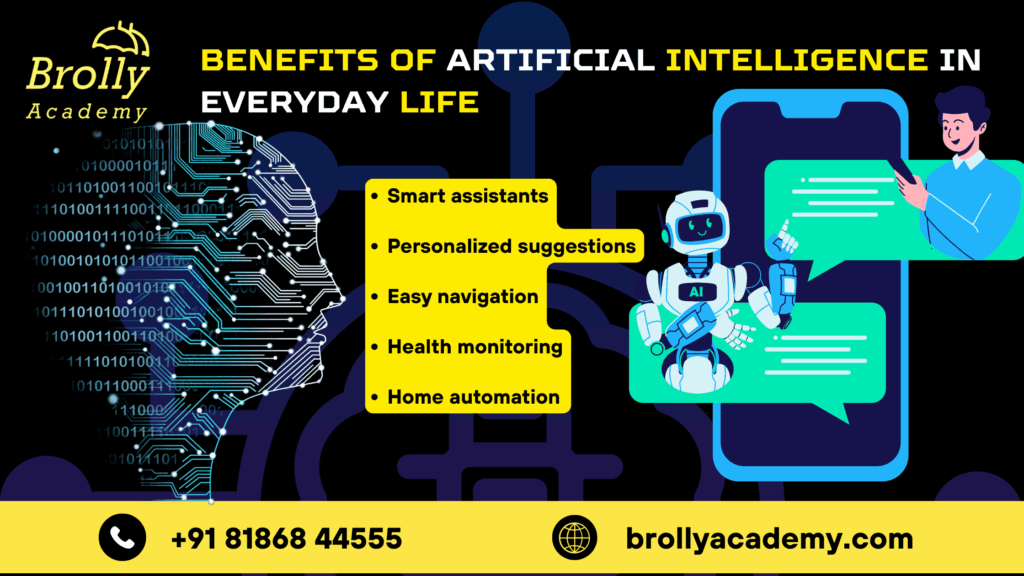
Benefits of Artificial Intelligence in Everyday Life
1. Convenience and Time-Saving
- Smart Home Automation:
Devices adjust lighting, temperature, and security settings automatically based on routines and preferences. - Voice Assistants : Setting reminders, creating shopping lists, or controlling devices through simple voice commands saves precious time and effort.
✅ Real-World Impact:
What once required minutes or hours of human attention now happens almost instantly, allowing people to live more productive and stress-free lives.
2. Hyper-Personalization
- Entertainment Platforms:
Netflix, YouTube, and Spotify recommend shows, videos, and music curated precisely for individual users. - E-commerce Personalization: Amazon, Etsy, and online retailers suggest products based on browsing habits, purchase history, and even predicted future needs.
3. Increased Safety and Security
- Cybersecurity Defense:
AI systems monitor network activity in real-time, detecting threats like phishing attacks, malware, and data breaches before they cause damage. - Physical Security:
Facial recognition secures access to devices and buildings, while smart surveillance systems distinguish between harmless and suspicious activities. - Road Safety Enhancements : Driver assistance features such as automatic braking, lane-keeping, and pedestrian detection powered by AI help prevent accidents.
4. Better Health Monitoring
- Wearable Health Trackers:
Devices like Fitbit, Apple Watch, and WHOOP monitor vitals such as heart rate, sleep cycles, oxygen saturation, and stress levels. - Early Detection and Alerts : AI can identify anomalies that indicate risks of heart disease, diabetes, sleep apnea, or other health concerns before symptoms are noticeable.
5. Efficiency and Resource Optimization
- Logistics and Supply Chain:
AI optimizes delivery routes, predicts inventory needs, and reduces transportation costs by analyzing traffic, weather, and consumer trends. - Energy Management:
Smart grids powered by AI predict consumption patterns, adjust power distribution dynamically, and minimize energy waste in homes and businesses. - Manufacturing Automation : Predictive maintenance powered by AI identifies when machines need repairs, preventing downtime and extending equipment life.
| Benefit Area | Practical Example |
| Convenience | Voice-activated reminders and smart home controls |
| Personalization | Netflix movie recommendations |
| Safety and Security | AI-based facial recognition for secure phone unlocking |
| Health Monitoring | Wearable devices detecting irregular heartbeats |
| Resource Optimization | AI logistics improving same-day delivery services |
Challenges and Ethical Concerns with AI in Everyday Life
1. Data Privacy and Surveillance
Real-World Concern:
Smart home devices and voice-activated assistants are sometimes found recording conversations without clear user consent, raising fears about “always-listening” technologies invading private spaces.
Key Insight:
Without transparent data policies, users may lose control over who accesses their most sensitive information, eroding trust in AI-enabled devices.
2. Algorithmic Bias and Discrimination
Real-World Concern : Studies have shown that some AI hiring platforms and facial recognition technologies exhibit higher error rates for women and people of color, leading to disproportionate disadvantages in employment and law enforcement.
Key Insight : Addressing bias is not optional; it is essential for building ethical, fair, and socially responsible AI systems that serve everyone equally.
3. Over-Reliance and Loss of Human Skills
As AI takes over more tasks, there is a growing risk of humans becoming overly dependent on technology.
Relying heavily on AI for decision-making, navigation, communication, and even thinking can erode critical skills such as problem-solving, spatial awareness, and independent judgment.
Real-World Concern:
Frequent use of GPS navigation has led to declining map-reading abilities in younger generations, while AI-driven recommendations could narrow human curiosity by filtering exposure only to “algorithmically approved” choices.
Key Insight:
Preserving human agency and critical thinking must remain a priority, even as AI makes life more convenient.
4. Job Displacement and Economic Disruption
Real-World Concern: Customer service centers increasingly use AI chatbots to handle inquiries, reducing the demand for human agents and making employment more precarious for low-wage workers.
Key Insight : Societies must invest heavily in reskilling programs and safety nets to ensure the workforce transitions smoothly into the AI-powered economy.
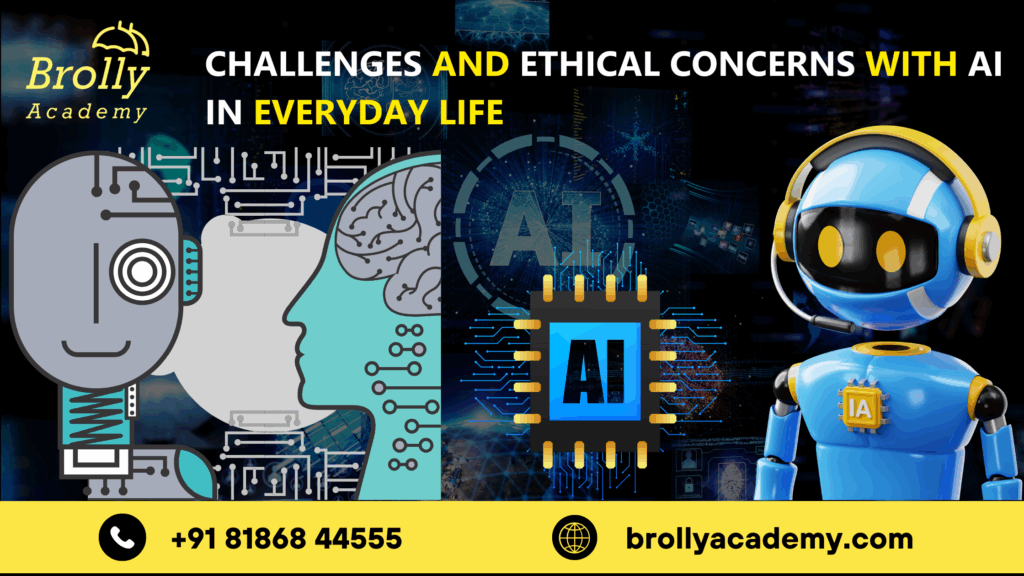
5. Environmental Impact
Real-World Concern : Studies estimate that training a single large AI model can generate as much carbon as five American cars over their entire lifetimes, highlighting the hidden environmental costs of rapid AI development.
Key Insight : Building greener AI — using more energy-efficient algorithms and sustainable computing infrastructure — is crucial to ensuring that technological progress does not come at the expense of the planet.
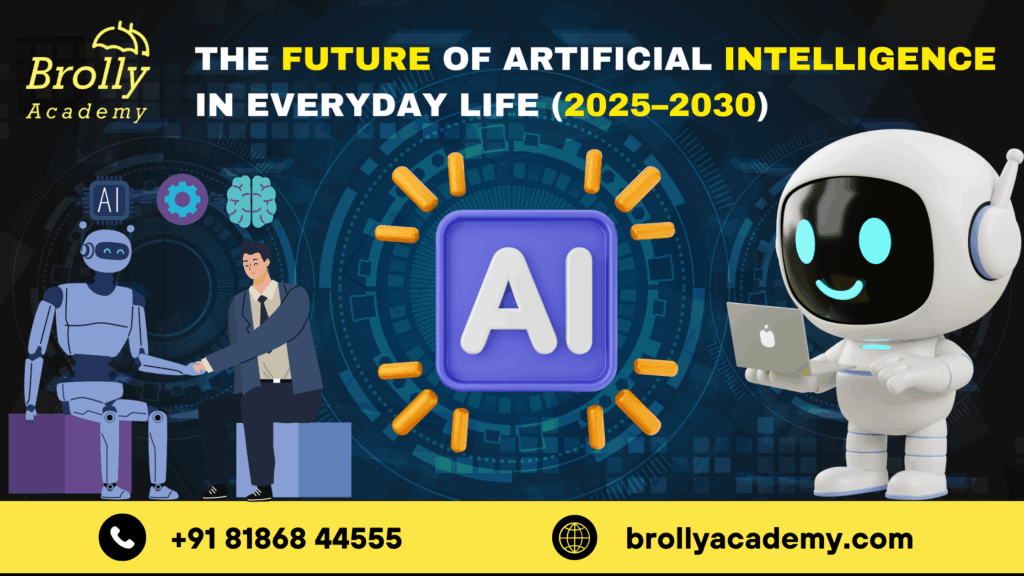
The Future of Artificial Intelligence in Everyday Life (2025–2030)
- Artificial Intelligence has already become an invisible engine driving convenience, personalization, and efficiency in daily life.
- Looking ahead to 2025 and beyond, its influence is expected to grow even deeper, more seamless, and more transformative.
- The next wave of AI integration will not just optimize isolated tasks — it will create living, breathing intelligent ecosystems that predict, adapt, and respond proactively to human needs.
Here are some key emerging trends shaping the future of everyday AI:
1. Predictive Smart Environments
Future homes, workplaces, and public spaces will increasingly shift from being passive structures to active, intelligent environments that sense needs and take action automatically.
- In Smart Homes:
Refrigerators will track inventory levels and reorder groceries automatically. Lighting, air conditioning, and entertainment systems will adjust intuitively to residents’ moods, schedules, and health conditions. - In Smart Workplaces:
Office spaces will optimize temperature, lighting, and energy usage dynamically based on real-time occupancy and employee preferences. - In Smart Cities:
Urban infrastructures will predict and manage traffic flow, public transport schedules, waste management, and energy distribution dynamically to maximize efficiency and reduce carbon footprints.
✅ Key Vision:
The environment itself will become an intelligent participant, anticipating and meeting human needs without conscious prompts.
2. AI Companions for Mental Health and Loneliness
The rise of emotionally aware AI agents will address one of society’s growing issues: loneliness and mental health challenges.
AI companions will be able to recognize emotional states — sadness, anxiety, joy — and respond empathetically in real-time, offering supportive conversations, therapeutic prompts, or alerts for human intervention when necessary.
- Elderly Support:
AI companions will provide continuous emotional companionship for aging populations, reducing feelings of isolation and supporting mental wellness. - Youth and Adults:
Personalized AI coaches could help individuals manage stress, track mental health trends, and suggest coping strategies tailored to their unique emotional profiles.
Example : Early prototypes like Replika AI already offer conversational emotional support, building “friendship” models that evolve with ongoing interactions.
✅ Key Vision : AI will not replace human relationships but will supplement emotional well-being when human contact is limited or unavailable.
3. Personalized Healthcare Advisors
Healthcare is poised for a dramatic AI-driven shift from reactive treatment to predictive, personalized wellness management.
- AI will analyze:
Individual genomes, biometric data, lifestyle habits, medication responses, and historical health records. - AI will recommend:
Customized preventive care strategies, early warning alerts for diseases, nutrition plans, and lifestyle adjustments tailored precisely to each individual’s needs. - Remote Monitoring:
Wearable devices will provide real-time updates to AI advisors, allowing health recommendations to evolve continuously based on live physiological data.
✅ Key Vision : Everyone could have access to a “personal doctor” in their pocket — predicting potential health issues before symptoms appear and guiding everyday health decisions intelligently.
4. Hyper-Localized Personalization
In the next era, AI personalization will move beyond broad categories into deep contextual micro-personalization.
- For Entertainment:
Streaming services will not just recommend shows based on genre but based on your current mood, the time of day, and even whether you’re watching alone or with friends. - For Education:
Learning platforms will dynamically adapt lesson plans minute-by-minute based on student attention levels, emotional states, and real-time comprehension metrics. - For Marketing:
Retailers will deliver offers and experiences tailored to where you are, what you are doing, and what micro-moment you are experiencing — not just demographic profiles.
✅ Key Vision : Every interaction will feel handcrafted, shifting from “one-size-fits-all” experiences to “one-size-fits-YOU” services.
5. Integration with Quantum Computing
The union of AI and quantum computing will unleash problem-solving capabilities previously thought impossible.
- Medicine: AI models will simulate molecular interactions in minutes, accelerating drug discovery and personalized treatment design.
- Climate Science: AI will model planetary systems at a scale complex enough to predict climate phenomena decades ahead.
- Cybersecurity: AI and quantum technologies will create nearly unbreakable encryption standards — and equally powerful decryption threats — transforming global digital security.
- Material Discovery: AI will help discover new materials for energy storage, construction, and technology that dramatically outperform today’s capabilities.
✅ Key Vision : AI supercharged by quantum computing could solve grand challenges in science, medicine, and the environment that are currently beyond human reach.
